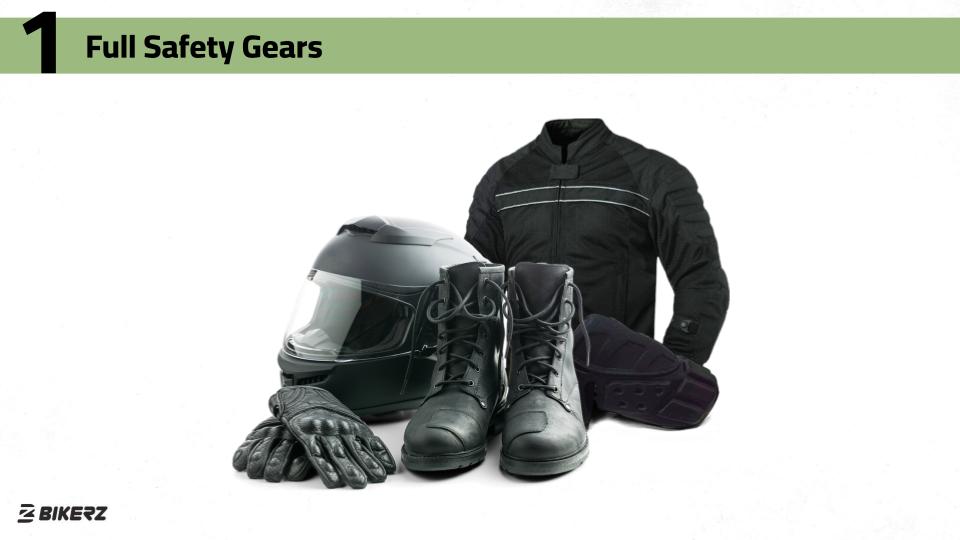Helmets
The Importance of Helmet Sizing
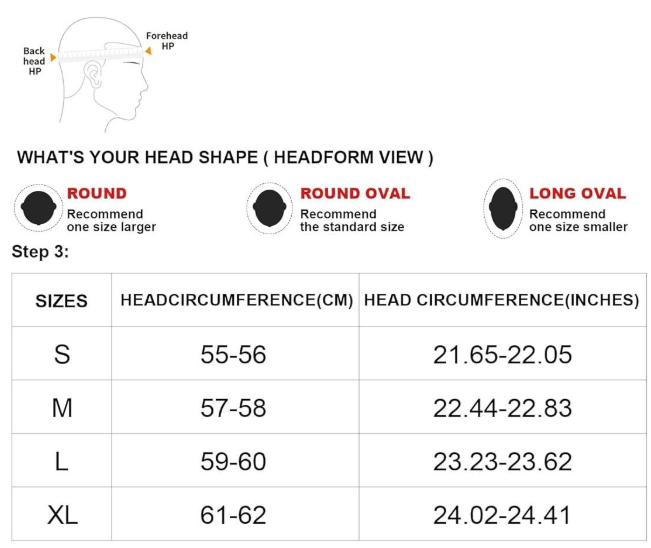
A helmet that doesn’t fit properly won’t protect you. A loose helmet can shift during a ride, while one that’s too tight can cause discomfort. Measure your head’s circumference about an inch above your eyebrows, and consult the manufacturer’s sizing chart. If you’re between sizes, opt for the smaller one; helmets naturally break in over time.
Types of Helmets:-
• Full-Face Helmet: Offers complete coverage for maximum protection. Ideal for sport, touring, and everyday street riding.
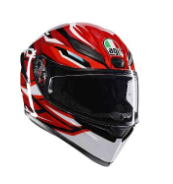
• Modular Helmet: Combines full-face protection with the ability to flip up the chin bar. Great for touring and commuting.
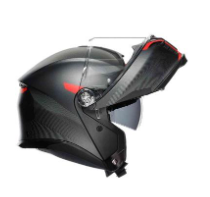
• Open-Face Helmet (3/4): Provides good visibility and ventilation, suitable for cruisers and city riding.

• Half Helmet: Minimal coverage, typically used for casual short rides. Not recommended due to its lack of safety features.
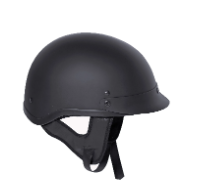
• Dual-Sport Helmet: Hybrid between off-road and street helmets. Designed for adventure and dual-sport riders. Has a face shield, a smoother shape with a shorter chin bar.
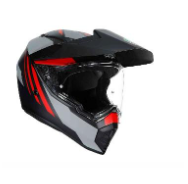
• Off-Road Helmet: Designed specifically for motocross and dirt biking. No face shield, bulkier in shape, and more extended chin bar.
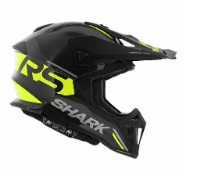
What are Helmet certifications?
Helmet certifications are official safety standards set by organizations around the world to ensure helmets offer adequate protection in the event of a crash. These certifications are achieved through rigorous testing that evaluates how well a helmet absorbs impact, resists penetration, stays secure, and handles real-world accident scenarios.
When you choose a helmet that meets these certifications, you’re ensuring a baseline level of safety that has been independently verified. It’s important to understand these certifications because not all helmets offer the same level of protection, and the testing standards can vary between regions. These certifications are found on the back of the helmet.
Types of Helmet certifications:-
• DOT (Department of Transportation):

Mandatory in the United States, this certification focuses on impact resistance, penetration, retention system effectiveness, and field of vision. DOT is a basic standard but does not require independent lab testing.
• ECE (Economic Commission for Europe):

One of the most rigorous standards globally. Helmets are tested in various conditions, including different speeds and angles. The latest ECE certificate is ECE22.06 as of 2025. The ECE 22.06 improves on the previous 22.05 standard by adding rotational impact testing and testing for accessories like visors and communication systems.
• SHARP (Safety Helmet Assessment and Rating Program):

A UK-based rating system that provides a star rating (out of 5) based on extensive lab testing. It’s a supplemental guide, often used in conjunction with ECE or DOT certifications. Choosing a helmet with proper certification ensures you are wearing a product designed and tested to protect you when it matters most. When choosing your helmet, always ensure it has the required certification based on your type of riding. For most riders, a helmet with ECE 22.06 certification is more than sufficient, offering a high standard of safety and performance for a variety of riding conditions. However, other certifications like Snell or DOT may be appropriate depending on regional requirements or specific riding needs.
• Snell (Snell Memorial Foundation):

A voluntary certification known for its demanding standards. Snell tests include additional impact points and higher energy levels, making it popular among racing helmets.
Top Brands:
Italian Brands:
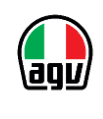
• AGV (Italy): AGV Helmets is one of the most respected and recognized names in motorcycle helmet manufacturing. Founded in 1947 by Gino Amisano in Valenza, Italy, AGV has built a reputation for innovation, quality, and performance. The brand name “AGV” stands for Amisano Gino Valenza—a tribute to its founder and its place of origin.
key features of AGV helmets:
▪ Advanced materials like carbon fiber and fiberglass composites.
▪ Exceptional aerodynamics and wind tunnel-tested designs.
▪ High ventilation efficiency for comfort during long rides.
▪ Race-bred technology is available for all riders.
 • Alpinestars (Italy): An iconic Italian brand founded in 1963 by Sante Mazzarolo, is best known for its racing suits, boots, and gloves. More recently, they have expanded into helmet manufacturing, leveraging their racing heritage.
• Alpinestars (Italy): An iconic Italian brand founded in 1963 by Sante Mazzarolo, is best known for its racing suits, boots, and gloves. More recently, they have expanded into helmet manufacturing, leveraging their racing heritage.
Key features of Alpinestars helmets:
▪ Race-focused design.
▪ Advanced safety technology.
▪ Premium materials.

• Nolan (Italy): Founded in 1972, Nolan Helmets specializes in modular and touring helmets made in Bergamo, Italy.
Key features of Nolan helmets:
▪ Fully Italian made.
▪ Integrated communication options.
▪ Excellent modular designs.

• Suomy (Italy): Was founded in 1997 in Italy. Known for bold graphics and race-bred technology.
Key features of Suomy helmets:
▪ Aggressive styling.
▪ Racing heritage.
▪ Lightweight construction.
Japanese brands:
 • Arai (Japan): is a prestigious Japanese helmet manufacturer, renowned for their handcrafted quality and commitment to rider safety. Founded in 1926 by Hirotake Arai, the company remains a family-run business dedicated to producing some of the safest and most reliable helmets in the world. Originally making protective headgear for industrial use, Arai transitioned into motorcycle helmets in the 1950s. Their meticulous handcrafting process ensures each helmet meets rigorous safety and quality standards. Arai focuses on real-world impact scenarios rather than just laboratory tests. Their helmets are known for their Round, Smooth, and Strong (R75) shell shape, designed to better manage and deflect
• Arai (Japan): is a prestigious Japanese helmet manufacturer, renowned for their handcrafted quality and commitment to rider safety. Founded in 1926 by Hirotake Arai, the company remains a family-run business dedicated to producing some of the safest and most reliable helmets in the world. Originally making protective headgear for industrial use, Arai transitioned into motorcycle helmets in the 1950s. Their meticulous handcrafting process ensures each helmet meets rigorous safety and quality standards. Arai focuses on real-world impact scenarios rather than just laboratory tests. Their helmets are known for their Round, Smooth, and Strong (R75) shell shape, designed to better manage and deflect
impact energy.
Key features of Arai helmets:
▪ Handmade craftsmanship.
▪ Proprietary shell construction.
▪ Superb ventilation systems.
▪ Focus on impact management and rotational energy mitigation.
 • Shoei (Japan): This is another esteemed Japanese helmet brand, known for its cutting-edge technology and precise craftsmanship. Founded in 1959 by Eitaro Kamata, Shoei has become synonymous with premium motorcycle helmets. Shoei introduced the world’s first carbon fiber helmet and continues to lead in helmet innovation with extensive wind
• Shoei (Japan): This is another esteemed Japanese helmet brand, known for its cutting-edge technology and precise craftsmanship. Founded in 1959 by Eitaro Kamata, Shoei has become synonymous with premium motorcycle helmets. Shoei introduced the world’s first carbon fiber helmet and continues to lead in helmet innovation with extensive wind
tunnel testing and design refinements.
Key features of Shoei helmets:
▪ Advanced shell construction.
▪ Excellent noise reduction.
▪ Aerodynamic designs tested in wind tunnels.
▪ Multiple shell sizes for optimized fit.
South Korean Brands:

• Scorpion (South Korea): Scorpion EXO is known for providing high-quality helmets at competitive prices. Owned by Kido Sports, Scorpion combines innovative technology with affordability and protective designs.
Key features of Scorpion helmets:
▪ AirFit cheek pad system for custom fit.
▪ Advanced polycarbonate and fiberglass construction.
▪ Excellent value for money.
American Brands:
![]()
• Icon (USA): Icon Motosports was founded in 2002 in Portland, Oregon, USA. Known for bold graphics and aggressive designs, Icon appeals to urban riders and stunt communities.
Key features of Icon helmets:
▪ Striking graphics.
▪ Focus on urban and street riders.
▪ Versatile designs with safety features.

• Bell (USA): Bell Helmets was founded in 1954 in California, USA. Bell is a pioneer in helmet safety and design, producing helmets for motorsports, cycling, and powersports.
Key features of Bell helmets:
▪ Multi-directional Impact Protection System (MIPS).
▪ Advanced impact absorption liners.
▪ Wide product range.
German Brands:

• Schuberth (Germany): Founded in 1922, Schuberth is a German helmet manufacturer specializing in high-end quiet, aerodynamic touring helmets known for quietness and comfort.
Key features of Schuberth helmets:
▪ Exceptional noise control.
▪ Integrated communication systems.
▪ Wind tunnel-tested aerodynamics.
French Brands:

• Shark (France): Shark Helmets was founded in 1986 in Marseille, France. Known for aggressive styling and racing performance.
Key features of Shark helmets:
▪ Carbon fiber shells.
▪ High safety ratings.
▪ Distinctive design language.


